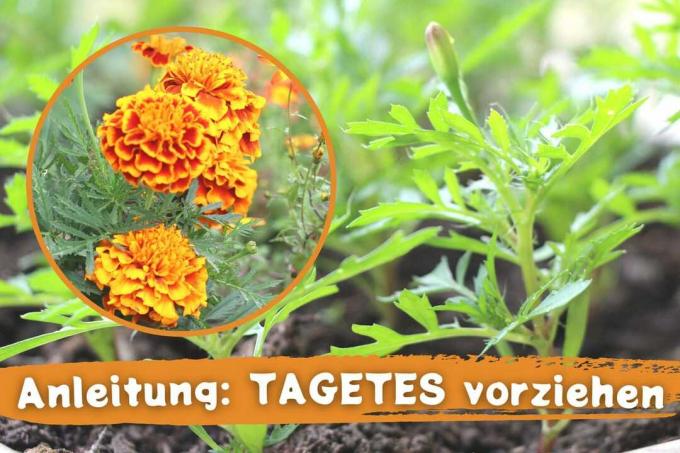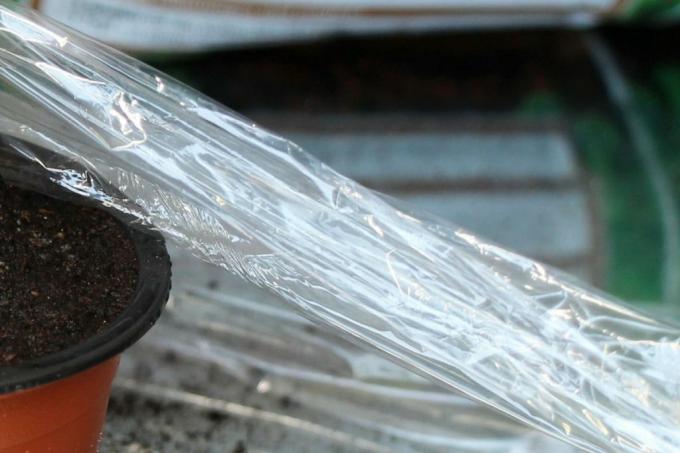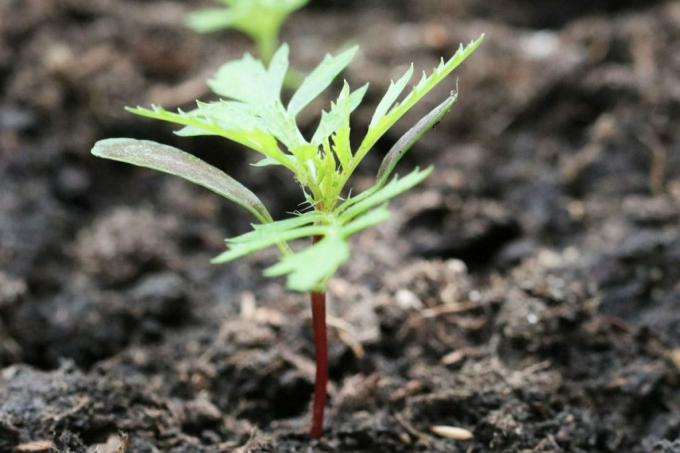
table of contents
- Watch out for the best time
- Use suitable growing containers
- Choose the ideal potting soil
- Sow right
- Keep soil moist
- Find the ideal location
- Prick out correctly
- Plant out at the right time
- frequently asked Questions
If you don't want to wait so long to sow in the bed, you prefer the marigold on the windowsill. This is very easy with the Asteraceae. This is how you can bring forward Tagetes.
In a nutshell
- Pre-breeding possible from January / February, but not recommended
- More suitable in mid / late March
- Cultivation for earlier flowering is advantageous
- Choose the right container and substrate
- prick out indispensable when pulling forward
Watch out for the best time
Plant lovers often show their Tagetes cultivation on the Internet as early as January / early February. The official date will be from the end of February to March. Experienced experts advise, however, not to start growing until mid-March, or better at the end of March. The reason: they have a relatively rapid growth and as smaller young plants they survive moving outdoors better.
Use suitable growing containers
There are various ways in which seeds can be distributed and pre-cultivated. Not every container is ideal for pulling out marigolds.
Cultivation box
Special cultivation boxes are available from specialist retailers for pre-cultivation. They consist of several small "seed chambers" and are usually much shallower than conventional pots. This means that more oxygen also reaches the depths of the earth, which has a positive effect on root development. In addition, this property reduces the risk of mold formation.
Flower pot or planter
Flower pots and tubs should not be used for cultivation. Usually they are too high and accordingly there is a lot of depth in the earth so that the seeds are high enough and receive the light they need for germination. This depth of the earth increases the risk of mold because the earth must be kept continuously moist. Mold inhibits germination and root growth. In the worst case, the seed will fail or the young plant will die.
Egg cartons

You can often read about the use of egg cartons for cultivation. Their functionality is similar to that of the propagation boxes and everyone has them at home. Due to the flat height and the individual chambers, seeds of the marigold can be easily distributed in it.
Plastic household jars
For the cultivation of marigolds, plastic boxes can also be used under certain conditions as an alternative to special cultivation boxes. They should also be flat in height. Ideally, they have a drainage hole so that excess moisture can escape from the depths of the earth. They must be cleaned thoroughly before use.
Metal vessels
Be careful with metal containers such as tins or paint cans. If the metal coating inside is damaged, harmful substances can migrate into the earth. If the humidity remains constant, rust formation is also promoted, which especially does not benefit the delicate roots. The result is a negative impact on germination and growth. In particular, metal vessels containing "questionable" substances such as paint or thinner should not be used even after thorough cleaning. Experience has shown that harmful residues are almost always left behind.
Choose the ideal potting soil
Choosing the right soil is particularly important for successfully growing marigolds. Nutrient-poor soil should definitely be used. If cultivation containers are filled with nutrient-rich soil, as found in normal flower and garden soil, the young plants will grow too quickly. This robs them of an enormous amount of energy, which weakens them overall and allows fewer roots to form. This means that the aboveground, extensive plant parts cannot be adequately supplied. Among other things, this makes them susceptible to diseases, pests and care errors.

The following materials are best suited for cultivation up to the point of pricking:
- special nutrient-poor potting soil from the trade
- unfertilized coconut fiber
- Mix one part each of finely crumbly / loose garden soil, deposited compost and sand
- Depleted garden soil from vegetable patches after harvesting Heavy consumers such as potatoes
- Bark humus
Sow right
Once the suitable cultivation container has been found and the ideal soil is filled in, the seeds are inserted. It is important to note that the seeds of the marigold are light germs. The following is the best practice for sowing:
- Spray water on the surface of the soil before sowing and press lightly
- Use your finger to press the indentation 0.5 centimeters deep into the earth
- Put in seeds and cover thinly with soil
- when growing in an unlimited container without individual chambers: keep a distance between seeds of three to five centimeters
Keep soil moist
The main challenges in growing marigolds are preventing mold from forming and to ensure a constantly high level of soil moisture without waterlogging and overwatering provoke.
Foil cover

Sufficient and continuous soil moisture can be optimally achieved if a translucent film is stretched over the cultivation vessel. After sowing, the soil is moderately moistened. Due to the film, the moisture remains much longer. As a result, less and less water has to be administered. This avoids overwatering.
ventilation
The seeds need oxygen to germinate. This is quickly used up under a film. Therefore, the film should be removed at least once a day for 15 to 20 minutes so that air can be exchanged. The "opening time" offers the optimal moment to slightly loosen the soil around the seed. Mold forms less often in loose soil.
Tip: As soon as you recognize the first leaflets after germination, the film should be removed immediately, because of Now the young plant stores moisture and the risk of mold would be maximized through the foil rise.
Find the ideal location
The marigold seed needs warmth and light in order for it to germinate. A place on the windowsill is ideal.
These details should also be kept in mind:
- Ambient temperature: between 18 and 20 degrees Celsius
- Light: sunny to partially shaded, no full sun; ideal windowsill in a south-easterly direction
- Avoid drafts
Prick out correctly
If the location, moisture content, substrate quality, temperature and light conditions are correct, the first cotyledons are visible after about eight to ten days. The growth is now so fast that they increasingly need more space. So that the roots do not get in each other's way when planting multiple times in one container, they must be separated from each other in good time. Individually planted specimens should be transplanted into a larger pot so that the roots can spread out as best as possible.

The following are the most important tips for pricking:
- Best time: around three to four weeks after the appearance of the first cotyledons and a hand's width
- Fill new, larger planters with soil
- If there is no pricking stick, shish kebab skewers, thin branches or popsicle sticks are suitable
- Push away loose soil around the plants
- Press the pricking stick at an angle under the plant about one centimeter in front of the plant stem
- carefully pry up the plant (roots are completely removed without tearing)
- then place (separately) in a new container
Tip: Cut the tips of the marigold flower as soon as five to six leaves have formed to support bushy growth.
Plant out at the right time
Tagetes can be planted in the bed, balcony box or container after they have been successfully grown, as soon as frost is a thing of the past. Hobby gardeners often do this as early as April, when temperatures rise well above freezing and spring is showing its most beautiful side. But be careful, because there can still be frosts until mid-May. Because even short-term ground frost is enough to prevent symptoms of frostbite on the young, yet Because of the delicate marigold, it should never be outdoors before the ice saints in mid-May be set.

frequently asked Questions
With cultivation on the windowsill you gain a "head start" in terms of time. Do not sow directly into the garden bed until April or May, usually wait well into summer for a lush flowering. Because of the pre-breeding, marigolds bloom as early as June.
It is not advisable to do so. Watering cans automatically bring pressure with them when watering, which is created by the punctiform spout and cannot be avoided. This means that there is a risk that the earth around the seed will be pushed away. In addition, the seeds could be washed away by the water pressure. Both factors make root formation and rooting more difficult. Therefore, basically limit yourself to spraying with a wide nozzle setting.
If you follow the tips mentioned, marigold flowers will already have a solid structure by the time they are pricked out. Nutrients are beneficial for their further growth. Therefore, the young plants can be transferred to normal substrate. Make sure that it does not contain a particularly high nitrogen content, as this "unnaturally" accelerates growth. It is best to use a high-quality substrate with perlite, which is well water-permeable and loose.
